
Bulletin 3 (II:1), 1964
Home
Français
Introduction
History
Annual Index
Author &
Subject
Credits
Contact
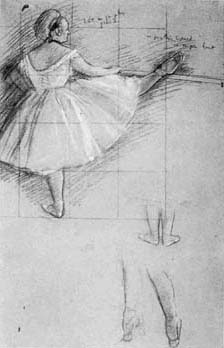
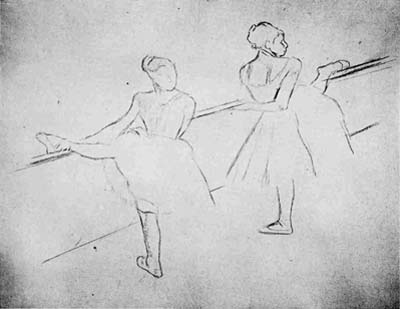
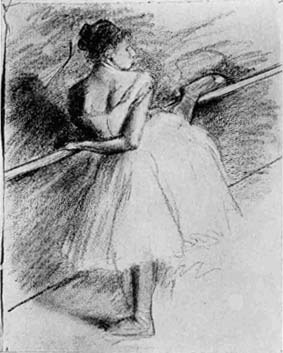
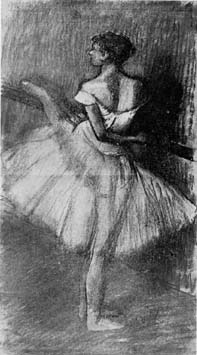
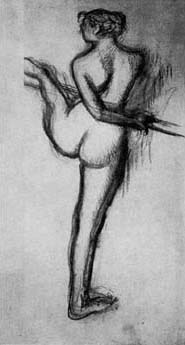
Danseuses à la barre by Degas
by Jean Sutherland Boggs,
author, curator, The Art Gallery of
Toronto
Résumé en français
Pages 1 | 2
| 3
The Danseuses à la Barre (Fig. 9) by Edgar Degas, in
the collection of the National Gallery of Canada, illustrates a
crucial problem in studying the later works of this painter. It is
not a problem of authenticity; this pastel was in Degas' studio at
the time of his death, and was sold in the first sale of its
contents (1) and illustrated in the catalogue. Nor is there any
question about its provenance, which can be traced from the
distinguished dealer, Jacques Seligmann, who bought it at that sale,
and from whose own sale in 1921 it was daringly purchased by the
National Gallery. (2) It is thoroughly documented, not only in the
two sales catalogues, but also in the standard catalogue of the
painter's work by M. Lemoisne (3) and in the book on Degas Dancers
by Miss Lillian Browse. (4) In spite of this formidable
background of knowledge about the work, including the fact that it
is one of several studies (5) for an oil painting (6) in the Phillips
Collection (Fig. 8) in Washington, the difficulty remains; it is
almost impossible to date the work with any precision.
The difficulty can, perhaps, be measured by the dates which have
been suggested for this pastel and for the other works related to
the Phillips oil. M. Lemoisne proposes c. 1884-88 for the
group, M. Jamot (a distinguished commentator upon Degas' work) c.
1890-95 (7), and Miss Browse c. 1900-05- a range of
twenty-one years in dating the works of an artist who died only in
1917. Even in Degas' earlier paintings of the dance the chronology
is not always clear although, in a recent issue of the Burlington (8),
Mr. Ronald Pickvance has taken an important step toward its
clarification by his examination of documents and reviews.
How can one find a date for the National Gallery's pastel -
presumably sometime within those twenty-one years from 1884, when
Degas was fifty, to 1905? Exhibitions are not helpful. The last of
those of the Impressionists or Independents was held within this
time, in 1886, but Degas did not exhibit any studies of dancers in
it. (9) Only one of his notebooks is preserved from this period and
it is from the same year, 1886. (10) Witness accounts of the artist
are not sufficiently precise to be able to separate one set of
studies of the ballet from others. Consequently we are forced to
depend upon the stylistic evidence of his dated works. And even here
there are difficulties since Degas dated only 25 (11) of the over 700
works M. Lemoisne catalogued from 1884 until the end of the artist's
career, and only one of these (12) is, like the Phillips version of
Ottawa's work, an oil, and only one (13) a painting of the dance.
Before using these 25 works as a basis for dating this pastel, it
would seem wise to stop to consider the subject and the painter's
use of it before the earliest date suggested by M. Lemoisne.
Although from the moment in 1872 that he began to make the ballet
one of his principal themes Degas was as much interested in classes
and rehearsals as in finished performances, he only occasionally
drew or painted dancers limbering themselves up at the barre. Quite
early in his studies of the dance he made a charcoal and pastel
drawing (Fig. 1) of such a ballerina (14), in which he emphasized the
ease with which she balanced herself and the strength in the leg
muscles which supported her. Degas did not idealize her sturdy body
or the features of her face but he did use the light of the pastel
to make her dress a romantically luminous thing.
It was probably only a year or two later that Degas painted the
charming small work (Fig. 2) which is now in the Metropolitan
Museum (15) and which, when it was sold at the auction of the
collection of his friend, Henri Rouart, in 1912 for 435,000 francs,
caused Degas to remark "Je suis comme le cheval qui gagne le
grand prix et qui n'a que son avoine." (16) The small dancer at
the right is in somewhat the same position as the ballerina in the
other drawing, but the emphasis is not upon her skill but upon her
endearingly youthful difficulties. Her arms and shoulders seem
frail, and, the little we can see of her hair and face, wistfully
appealing. This assumption of a specific personality can remind us
of the painter's interest in portraiture at the same time.
Somewhat later, in working toward a composition like the earlier
painting, (17) Degas made studies (Figs. 3 and 4) of an equally
youthful and awkward ballerina. He was, however, more mocking than
tender, for there is an unsentimental insouciance in this ballerina
's ungainliness. Instead of the delicate articulation of the body
and the suggestions of movement through that body, as one finds it
in the Metropolitan's painting, the motion is reinforced by the
abrupt, harsh, and angular movements of Degas' piece of charcoal or
pastel. The strength of the thrust of our eyes through space is
particularly apparent in the compositional drawing. The effect of
these drawings is consequently vigorous and without any allusion to
the graceful ballerina who might emerge, as we somewhat poignantly
expect her to do from the young dancer in the Metropolitan's
painting.
These studies break into the period which M. Lemoisne suggests for
Ottawa's pastel. The combination of realism, wistfulness and humour
and the strength of the characterization in the profile can be found
in Degas' portrait of Mme Henri Rouart, (18) which is dated 1884, and
in his triple portrait of Mlle Salle (19) which is dated 1886. Its
energy in space as well as the thrust of the body can be found in a
small work called Le Café Concert (20) from 1885. The
rapidity of the charcoal strokes, and the suggestion of light and
shadow with them, is not unlike the drawing of Mme Rouart or a
drawing for one of the bathers which is dated 1885 (21) And the
respect for physical energy reinforced by the artist's own energetic
use of abstract means is like the great bathers which Degas dated
1884-86, (22) probably in preparation for the last exhibition of the
Impressionists.
Next Page | Ottawa's
pastel
1 | 2
| 3
Annual Index | Author & Subject | Credits | Contact
This digital collection
was produced under contract to Canada's Digital Collections program,
Industry Canada.
"Digital
Collections Program, Copyright
© National Gallery of
Canada 2001"